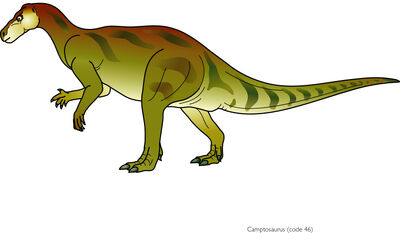
 
Camptosaurus (pronounced /ˌkæmptɵˈsɔrəs/ KAMP-to-SAWR-əs) is a genus of plant-eating, beaked dinosaurs of the Late Jurassic and Early Cretaceous Periods. The name means 'bent lizard', because, when standing on all fours, its body must have been arched (Greek καμπτος/kamptos meaning 'bent' and σαυρος/sauros meaning 'lizard').
Contents[] |
[edit] Discovery and species[]
[1][2]Historical skeletal restoration of Camptosaurus by O.C. Marsh, with skull based on remains now referred to Theiophytalia
[3][4]Cast of a Camptosaurus skull from Bone Cabin Quarry West, WyomingOriginally described by O. C. Marsh in 1879 as Camptonotus, or "bent back", it was renamed Camptosaurus in 1885 because the original name was already in use for a cricket. In 1879, Marsh named C. dispar (type species of the genus) and C. amplus for material he received from his collectors at Quarry 13 near Como Bluff, Wyoming in the Morrison Formation. Throughout the 1880-1890s, he continued to receive specimens from Quarry 13 and named two additional species: C. medius and C. nanus based in part on size. Charles W. Gilmore named two additional species, C. browni and C. depressus in his 1909 [1] redescription of the Marsh specimens. In the Morrison Formation, Camptosaurus fossils are present in stratigraphic zones 2-6.[2]
Then in 1980, Peter Galton and H.P. Powell in their redescription of C. prestwichi (see following), considered C. nanus, C. medius and C. browni to be different growth stages or different gender of the larger C. dispar, and therefore only C. dispar was the valid species. They also considered the skull referred to C. amplus by Marsh and by Gilmore to belong to C. dispar, as well. Gilmore had used this skull to describe the skull of Camptosaurus, but the specimen was recently shown by Brill and Carpenter [3] not to belong to Camptosaurus and put it into its own genus and species, Theiophytalia kerri.
A second species, Camptosaurus aphanoecetes, was recently named by Carpenter and Wilson [4] for specimens from Dinosaur National monument. It differs from C. dispar in the lower jaw, shorter neck vertebrae, and straighter ischium ending in a small "foot" among other features.
While Marsh was describing Camptosaurus species in North America, numerous species from Europe were also referred to the genus in the late 19th and early 20th centuries, as well: C. inkeyi, C. hoggii, C. leedsi, C. prestwichii, and C. valdensis. C. inkeyi and C. leedsi consist of fragmentary material and species are no longer considered valid (nomen dubium). C. valdensis was moved to Valdosaurus canaliculatus by Galton in 1977 [5]. C. hoggii was originally named Iguanodon hoggii by Richard Owen in 1874 and was moved to Camptosaurus by Norman and Barrett in 2002.[6] It has since been transferred to the genus Owenodon.[7]
[5][6]Incomplete skeleton of C. prestwichii , sometimes referred to as "Cumnoria", Oxford University Museum of Natural HistoryThe remaining European species Camptosaurus prestwichii was recovered from Chawley Brick Pits, Cumnor Hurst in Oxfordshire in England. The fossil was found when a tramway was driven into the side of a hill. It was described by Hulke in 1880 as Iguanodon prestwichii, and then placed in its own genus Cumnoria by Seeley in 1888. It was moved to Camptosaurus by Lydekker in 1889 where it remains today.[8] However, Naish & Martill (2008) considered the generic distinction as valid. The holotype skeleton remains the best skeleton of Camptosaurus from Europe.
[edit] Paleobiology[]
The largest adult camptosaurs were more than 7.9 metres (26 ft) long, and 2 metres (6.6 ft) at the hips.[9] Average specimens reached 6m (19.7 feet) in length and 785 – 874 kg in weight.[10] This genus is probably closely related to the ancestor of the later iguanodontid and hadrosaurid dinosaurs and was more heavily derived than contemporaries like Dryosaurus, Drinker, or Othnielosaurus.[10] Its teeth were also more tightly packed in the jaw compared to other Morrison ornithopods.[10] Museum curator John Foster describes them as having "thick median ridges on their lateral sides and denticles along their edges," these features were similar to, but "more fully developed" than those in Dryosaurus.[10] Camptosaurus teeth frequently exhibit extensive wear, which indicates that individuals in the genus had a diet of relatively tough vegetation.[10] A tiny 9 inch fossilized Camptosaurus embryo was retrieved from Morrison Formation strata at Dinosaur National Monument in Utah.[10] Based on studies of other iguanodonts, scientists believe Camptosaurus may have been able to achieve running speeds of 25 km per hour (15 mph).[10]